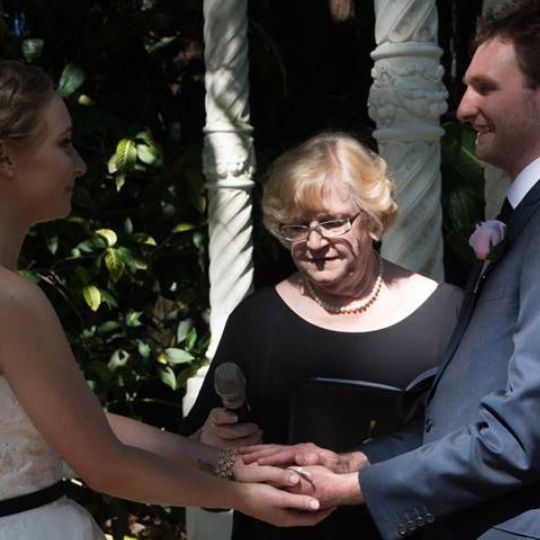Consent, Celebrants and the 'Real Estate Factor'
/08
by © Jennifer
Cram - Brisbane Marriage Celebrant Originally published in The Celebrant, Issue 13, September 2022, pp 20-31
Republished 02/03/2023 with the permission of the Editor.
Categories: | For Celebrants | Wedding Ceremony | Inclusive Weddings
A word to
non-celebrant readers
Facebook and Instagram posts by the Editor, Veronika Robinson, said this about this article: "An Absolute must-read article for any celebrant who claims to create ceremonies based on the client's beliefs."
 When marrying
couples hire and pay their celebrant, they expect us
to deliver a complex service that extends well
beyond delivery of a polished performance on the
day. As consumers, they have a right to expect that
we will be explicit about what we contract to
provide, and that we will honour both the letter and
the spirit of the contract. It is their wedding.
Their big day. So they expect that we will be
competent, ethical, and customer focused.
When marrying
couples hire and pay their celebrant, they expect us
to deliver a complex service that extends well
beyond delivery of a polished performance on the
day. As consumers, they have a right to expect that
we will be explicit about what we contract to
provide, and that we will honour both the letter and
the spirit of the contract. It is their wedding.
Their big day. So they expect that we will be
competent, ethical, and customer focused.In, Consent, Ceremonies, and Celebrants , I explored legal and ethical issues around the three types of consent that relate to the relationship between the marrying couple and between the couple and the legal institution of marriage: Real Consent, Informed Consent and Intimate Consent. I emphasized that celebrants need to be fully cognisant of and sensitive to these three different types of consent as they apply to the ceremony, to the process of getting married, and to marriage itself. Because we must accept responsibility for navigating whatever challenges these three types of consent present for the content of the ceremonies we write and perform.
Nothing we do, say, or imply in the ceremony should infringe the legal (as in Marriage Act) or moral aspects of consent as is it understood in the here and now, regardless of whether the couple fully understands them. Consumer law requires that we deliver what we are paid for, regardless of whether our clients fully understand their consumer rights.
As I discussed in that article, that our clients go along with what we do or say in the ceremony does not necessarily indicate that they agree with the subliminal messages the ceremony may convey. That they appear to accept what we tell them they must or should do, may be no more than an indicator that their assumptions are erroneous, they lack of knowledge, or we have done a good job of controlling their expectations. That they are resigned rather than willingly compliant.
In this current article, I turn to our ethical and legal responsibility to our couples as consumers of our celebrant services and how this relates to consent.
Professional
Standards and Celebrant Responsibility
For Australian celebrants, authorized to solemnize legal marriages, the Code of Practice requires that we
- respect the privacy and confidentiality of the parties
- deal appropriately with personal information
- ensure appropriate personal presentation
The boundaries of our role as celebrants reflect the rights of the consumers of our services. Regrettably, what appears to be a rapidly spreading practice linked with a burgeoning focus on visibility, branding, marketing, and self-promotion, does not align comfortably with a celebrant’s primary responsibility to the client. I call it the Real Estate Factor.
The Real Estate
Factor
Using the marketing of a property to market the agent to potential vendors, delivers no benefit to the vendor who funds that marketing. Indeed, quite the opposite. It is scarcity that drives prices up and results in quick sales while more properties for sale tend to depress prices and blow out time on the market.
The Real Estate Factor is alive and well in celebrancy with one notable exception. Unlike the property market, which cycles between a sellers market, where demand outstrips supply, and a buyers market, where there is an oversupply, for couples wishing to marry it is always a buyers market. There is no scarcity of celebrants. Indeed, the supply of celebrants increases day by day.
Regardless of how much we feel the need to put ourselves out there, we should never lose sight of the fact that our couples hire and pay us to be their celebrant, not a walking billboard promoting our celebrant business to guests at the ceremony, and to those who see the photographs they have hired and paid a photographer to take.
Transfer of
Value
When the something of value is a physical good, such as a pen or a packet of crisps, that good needs to be accurately described, and fit for purpose. The contract between seller and purchaser can, however, be implicit. And when demand increases, manufacturing can be stepped up without compromising quality.
When the something of value is a service, contracts need to be explicit because production of the service happens simultaneously with its consumption. The client does not have the opportunity to examine it before signing on the dotted line and paying the fee. It is, therefore, good business practice to manage purchaser expectations and avoid the disputes that can arise when assumptions are inaccurate; to spell out what the service comprises in a way that requires the client to actively consent and opt-in to the components of the service to be provided. That means no deficits and no unwelcome surprises. It also means being aware that we sell ourselves. Me. As an individual. And there will come a point where demand compromises the quality of what we can deliver.
In some countries, it is illegal to frame consumer contracts in terms of opt-out consent. Something we are all familiar with in terms of email lists and spam. But whether it is illegal in your jurisdiction or not, it is poor practice to frame the contract in a way that requires a client to opt out of giving permission, for example, rather than opting in to the celebrant’s use of photos of the couple and information about the couple in marketing their brand, services, and business. If the only way a couple can withhold permission is to not hire you in the first place, you are using opt-out consent.
Savvy celebrants know that the ceremony is important as an experience as well as creating a change in legal status. Savvy celebrants are aware that, on the day, how the ceremony makes the client feel will be their primary concern. The legal requirements are not at the forefront of their minds. Savvy celebrant contracts spell out what failure to comply with the relevant Marriage Act would mean.
Everything else involved in or around the ceremony is subject to opt-in consent. And I do mean everything. Ceremony content and choreography included. If you decide to manage demand by outsourcing the writing of your ceremonies (another growing practice) that should be made explicit in your contract and consent obtained along with consent for any other sharing of private information by the celebrant both before and after the ceremony.
Which brings me to the elephant in the room. And it is a big one, growing bigger by the day.
Celebrant
Branding, Marketing, and Consent
How one-way transfer of value works is something we celebrants should have no difficulty in understanding. We have been there. We ask for reviews and complain bitterly when the response is low, or when we are left off a long list of vendors being thanked in a social media post. Nonetheless, I’ve yet to see a celebrant acknowledge that expecting a couple to spend time and effort to write a review is expecting them (the couple) to give you something of immense value to your business, for nothing.
Promoting the celebrant’s brand in-ceremony blurs what should be a clear demarcation between the celebrant’s role in officiating a state-sanctioned legal ceremony and marketing that celebrant’s business with the business owner’s hat on.
I am noticing that the Marriage Register, embossed with the Commonwealth Coat of Arms, which makes visually clear that the celebrant is performing a legal service on behalf of the government, is disappearing off the signing table at Australian weddings. In its place we are seeing folders in personal brand colours with personal brand names embossed. Implying that the authority for the marriage is the brand rather than the law. Ditto for the reading folder, and for folders for vows.
Incentives
In Australia, offering an incentive for a five star review, whether in cash or in kind, breaches the Competition and Consumer Act. Such reviews are classified as fake or misleading and can attract a hefty fine. Incentives for reviews are only legal where they are offered solely for the purpose of encouraging all customers of the business to write reviews, regardless of whether those customers are likely to write a positive or negative review. The business must treat all reviews equally, and must prominently disclose details of the incentive to consumers. In the UK the Competition and Markets Authority (CMA) enforces similar requirements.
But offering an incentive for reviews or shares differs from offering an incentive to encourage consent to in-ceremony promotion of the celebrant’s business. A review is post-experience reflection on the service received. It in no way changes the experience itself. In-ceremony promotion happens during the ceremony and therefore inserts an element into the experience and potentially into the photographic record that does nothing to enhance the experience and may detract from it.
While the law is silent on a celebrant actively marketing their brand while solemnizing a marriage, I suspect, for couples, the only incentive they would consider would be a hefty discount on the ceremony fee in exchange for their consent to in-ceremony marketing of the celebrant’s business. Whether such practice would be acceptable to the relevant authorities when the service you provide includes solemnizing a legal marriage is a moot question. I would be very surprised if it was, particularly as “personal” brands are often business names which obscure the relationship between the celebrant and the legal record. Business or brand names never appear on the official documentation. It is the individual who is appointed to solemnize marriages and whose legal name must therefore be recorded on the official documentation.
In-ceremony marketing can be seen as an interrupt with the potential to erode the couple’s rights as consumers. Without the couple’s full and informed consent, it is shonky legal and ethical practice, wildly risky in an industry where reputation and word of mouth counts for a lot. It is particularly risky in a situation where, should aunties, grannies, and friends who were guests at the wedding make negative remarks about the celebrant promoting themselves during the ceremony, regardless of whether they consented, the couple may post negative and critical comments all over social media and lodge formal complaints with relevant authorities.
To paraphrase Gandhi’s advice to parents that your life is your message to your children, what a celebrant says and does sends a powerful message to their couples, current and potential. Couples want to feel that they are the most important couple in the world to their celebrant. Performing their ceremony with one eye on attracting the next booking, fails to achieve that.
Thanks for reading!

pullin0 Things